Analysis of SME Credit Access in Ga East Municipality, Ghana, 2022
VerifiedAdded on 2023/06/12
|72
|21458
|254
Project
AI Summary
This project investigates the factors influencing Small and Medium Enterprises (SMEs) access to credit within the Ga East Municipality of Ghana. It begins by highlighting the importance of SMEs to Ghana's economy, noting their contribution to employment and GDP. The study identifies challenges faced by SMEs in accessing finance, including the focus of financial institutions on larger corporations. The project aims to identify sources of credit available to SMEs, assess the impact of mobile phone access, firm size, and business age on credit accessibility. The research employs various methods and analytical tools to examine these determinants, ultimately providing evidence on the factors influencing credit access for SMEs in the Ga East Municipality and offering recommendations to improve financial inclusion and support for these businesses.

PROJECT WORK SUBMITTED TO THE SCHOOL OF GRADUATE STUDIES
ACCOUNTING DEPARTMENT IN PARTIAL FULFILMENT OF THE AWARD FOR
THE REQUIREMENT OF A MASTER OF BUSINESS ADMINISTRATION IN
ACCOUNTING AND FINANCE.
APRIL 2022
ACCOUNTING DEPARTMENT IN PARTIAL FULFILMENT OF THE AWARD FOR
THE REQUIREMENT OF A MASTER OF BUSINESS ADMINISTRATION IN
ACCOUNTING AND FINANCE.
APRIL 2022
Paraphrase This Document
Need a fresh take? Get an instant paraphrase of this document with our AI Paraphraser
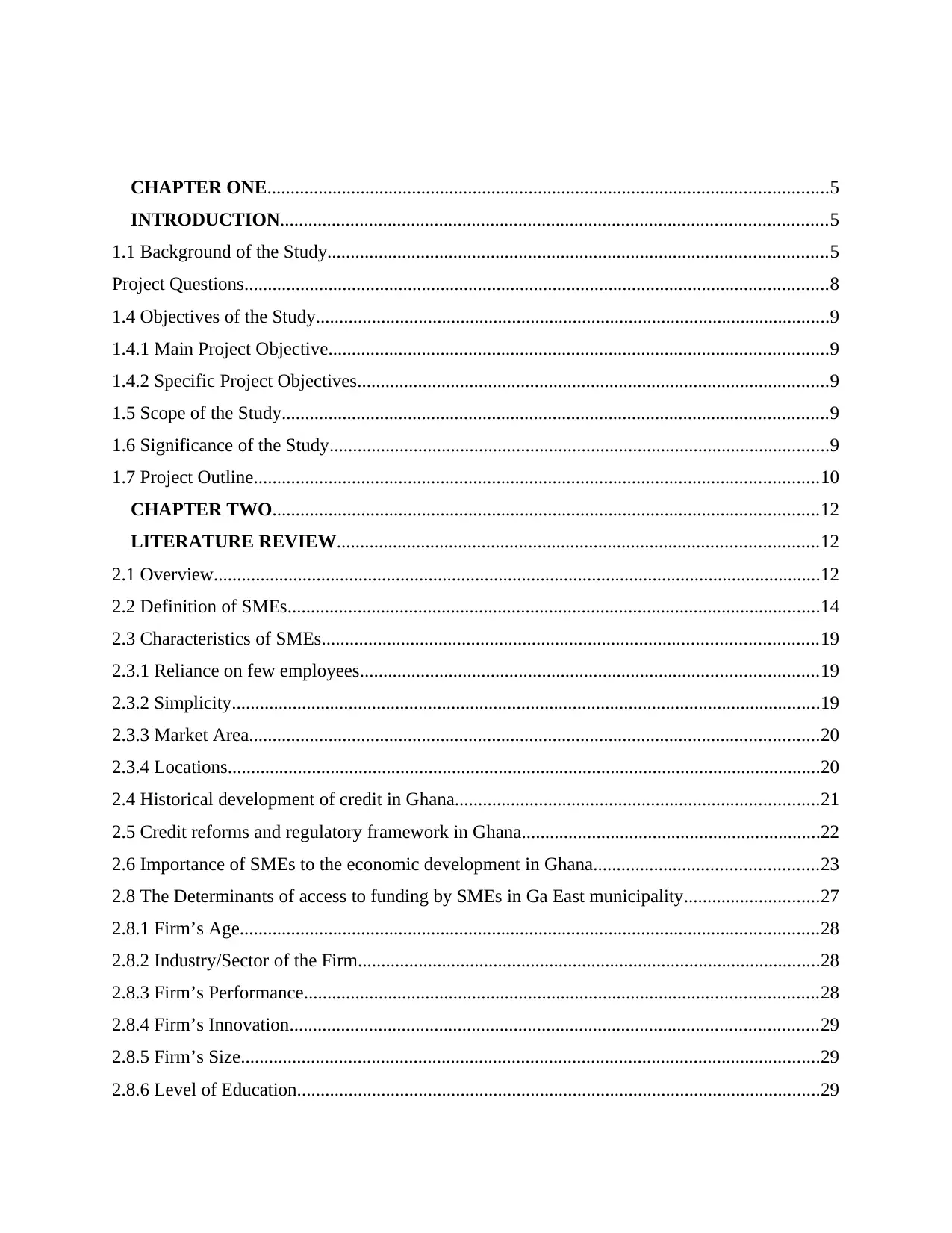
CHAPTER ONE........................................................................................................................5
INTRODUCTION.....................................................................................................................5
1.1 Background of the Study...........................................................................................................5
Project Questions.............................................................................................................................8
1.4 Objectives of the Study..............................................................................................................9
1.4.1 Main Project Objective...........................................................................................................9
1.4.2 Specific Project Objectives.....................................................................................................9
1.5 Scope of the Study.....................................................................................................................9
1.6 Significance of the Study...........................................................................................................9
1.7 Project Outline.........................................................................................................................10
CHAPTER TWO.....................................................................................................................12
LITERATURE REVIEW.......................................................................................................12
2.1 Overview..................................................................................................................................12
2.2 Definition of SMEs..................................................................................................................14
2.3 Characteristics of SMEs..........................................................................................................19
2.3.1 Reliance on few employees..................................................................................................19
2.3.2 Simplicity..............................................................................................................................19
2.3.3 Market Area..........................................................................................................................20
2.3.4 Locations...............................................................................................................................20
2.4 Historical development of credit in Ghana..............................................................................21
2.5 Credit reforms and regulatory framework in Ghana................................................................22
2.6 Importance of SMEs to the economic development in Ghana................................................23
2.8 The Determinants of access to funding by SMEs in Ga East municipality.............................27
2.8.1 Firm’s Age............................................................................................................................28
2.8.2 Industry/Sector of the Firm...................................................................................................28
2.8.3 Firm’s Performance..............................................................................................................28
2.8.4 Firm’s Innovation.................................................................................................................29
2.8.5 Firm’s Size............................................................................................................................29
2.8.6 Level of Education................................................................................................................29
INTRODUCTION.....................................................................................................................5
1.1 Background of the Study...........................................................................................................5
Project Questions.............................................................................................................................8
1.4 Objectives of the Study..............................................................................................................9
1.4.1 Main Project Objective...........................................................................................................9
1.4.2 Specific Project Objectives.....................................................................................................9
1.5 Scope of the Study.....................................................................................................................9
1.6 Significance of the Study...........................................................................................................9
1.7 Project Outline.........................................................................................................................10
CHAPTER TWO.....................................................................................................................12
LITERATURE REVIEW.......................................................................................................12
2.1 Overview..................................................................................................................................12
2.2 Definition of SMEs..................................................................................................................14
2.3 Characteristics of SMEs..........................................................................................................19
2.3.1 Reliance on few employees..................................................................................................19
2.3.2 Simplicity..............................................................................................................................19
2.3.3 Market Area..........................................................................................................................20
2.3.4 Locations...............................................................................................................................20
2.4 Historical development of credit in Ghana..............................................................................21
2.5 Credit reforms and regulatory framework in Ghana................................................................22
2.6 Importance of SMEs to the economic development in Ghana................................................23
2.8 The Determinants of access to funding by SMEs in Ga East municipality.............................27
2.8.1 Firm’s Age............................................................................................................................28
2.8.2 Industry/Sector of the Firm...................................................................................................28
2.8.3 Firm’s Performance..............................................................................................................28
2.8.4 Firm’s Innovation.................................................................................................................29
2.8.5 Firm’s Size............................................................................................................................29
2.8.6 Level of Education................................................................................................................29
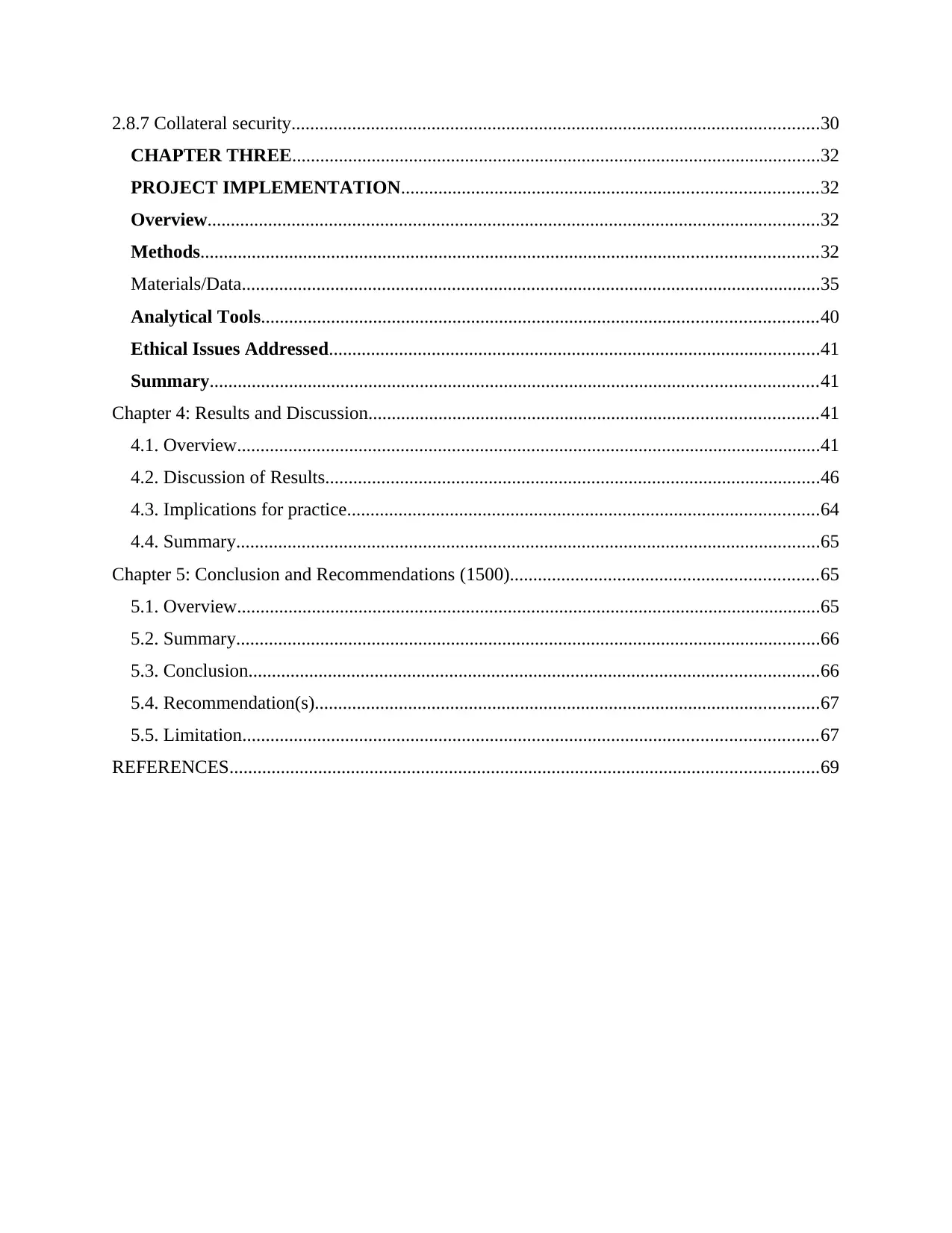
2.8.7 Collateral security.................................................................................................................30
CHAPTER THREE.................................................................................................................32
PROJECT IMPLEMENTATION.........................................................................................32
Overview...................................................................................................................................32
Methods....................................................................................................................................32
Materials/Data............................................................................................................................35
Analytical Tools.......................................................................................................................40
Ethical Issues Addressed.........................................................................................................41
Summary..................................................................................................................................41
Chapter 4: Results and Discussion................................................................................................41
4.1. Overview.............................................................................................................................41
4.2. Discussion of Results..........................................................................................................46
4.3. Implications for practice.....................................................................................................64
4.4. Summary.............................................................................................................................65
Chapter 5: Conclusion and Recommendations (1500)..................................................................65
5.1. Overview.............................................................................................................................65
5.2. Summary.............................................................................................................................66
5.3. Conclusion..........................................................................................................................66
5.4. Recommendation(s)............................................................................................................67
5.5. Limitation...........................................................................................................................67
REFERENCES..............................................................................................................................69
CHAPTER THREE.................................................................................................................32
PROJECT IMPLEMENTATION.........................................................................................32
Overview...................................................................................................................................32
Methods....................................................................................................................................32
Materials/Data............................................................................................................................35
Analytical Tools.......................................................................................................................40
Ethical Issues Addressed.........................................................................................................41
Summary..................................................................................................................................41
Chapter 4: Results and Discussion................................................................................................41
4.1. Overview.............................................................................................................................41
4.2. Discussion of Results..........................................................................................................46
4.3. Implications for practice.....................................................................................................64
4.4. Summary.............................................................................................................................65
Chapter 5: Conclusion and Recommendations (1500)..................................................................65
5.1. Overview.............................................................................................................................65
5.2. Summary.............................................................................................................................66
5.3. Conclusion..........................................................................................................................66
5.4. Recommendation(s)............................................................................................................67
5.5. Limitation...........................................................................................................................67
REFERENCES..............................................................................................................................69
⊘ This is a preview!⊘
Do you want full access?
Subscribe today to unlock all pages.

Trusted by 1+ million students worldwide

Paraphrase This Document
Need a fresh take? Get an instant paraphrase of this document with our AI Paraphraser
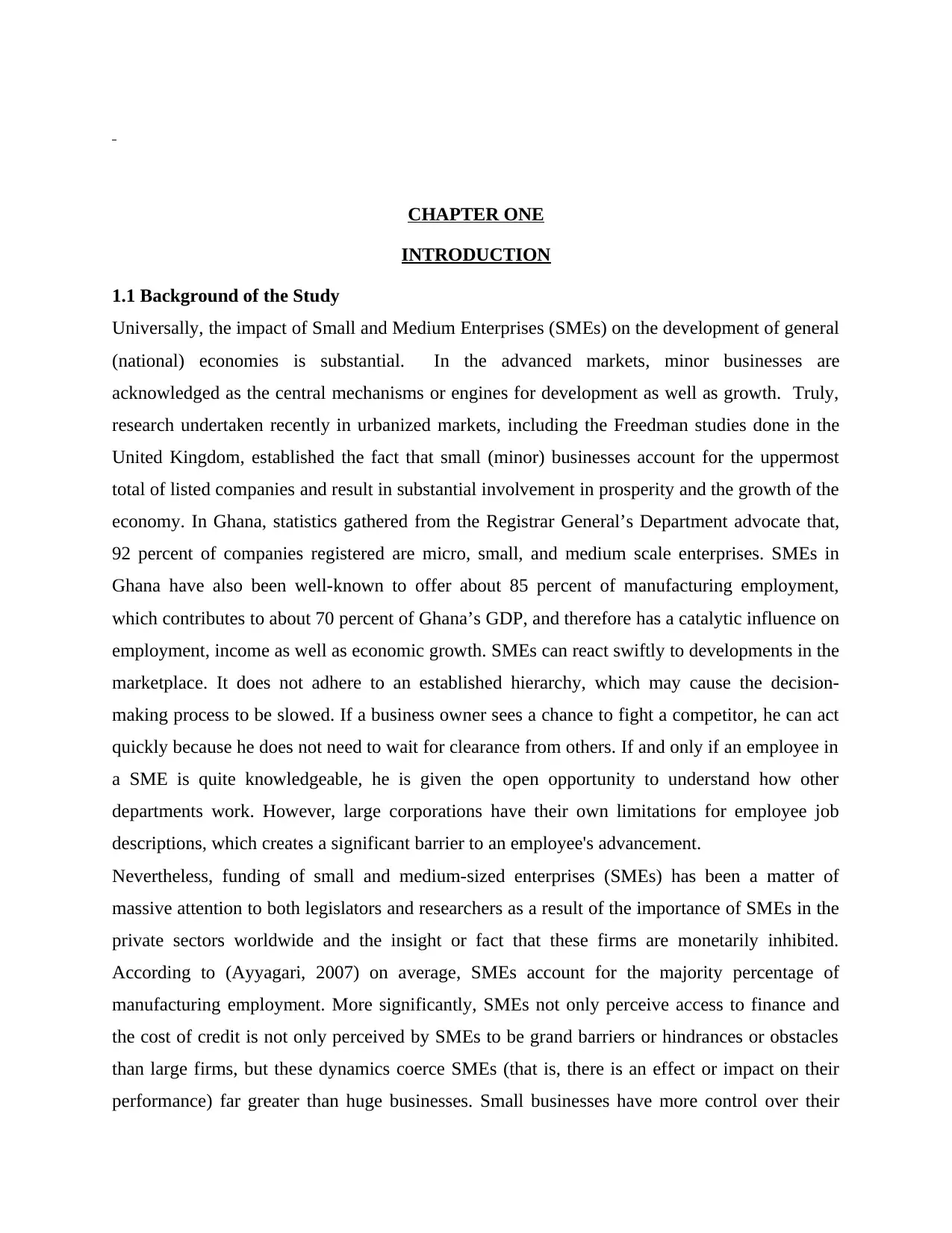
CHAPTER ONE
INTRODUCTION
1.1 Background of the Study
Universally, the impact of Small and Medium Enterprises (SMEs) on the development of general
(national) economies is substantial. In the advanced markets, minor businesses are
acknowledged as the central mechanisms or engines for development as well as growth. Truly,
research undertaken recently in urbanized markets, including the Freedman studies done in the
United Kingdom, established the fact that small (minor) businesses account for the uppermost
total of listed companies and result in substantial involvement in prosperity and the growth of the
economy. In Ghana, statistics gathered from the Registrar General’s Department advocate that,
92 percent of companies registered are micro, small, and medium scale enterprises. SMEs in
Ghana have also been well-known to offer about 85 percent of manufacturing employment,
which contributes to about 70 percent of Ghana’s GDP, and therefore has a catalytic influence on
employment, income as well as economic growth. SMEs can react swiftly to developments in the
marketplace. It does not adhere to an established hierarchy, which may cause the decision-
making process to be slowed. If a business owner sees a chance to fight a competitor, he can act
quickly because he does not need to wait for clearance from others. If and only if an employee in
a SME is quite knowledgeable, he is given the open opportunity to understand how other
departments work. However, large corporations have their own limitations for employee job
descriptions, which creates a significant barrier to an employee's advancement.
Nevertheless, funding of small and medium-sized enterprises (SMEs) has been a matter of
massive attention to both legislators and researchers as a result of the importance of SMEs in the
private sectors worldwide and the insight or fact that these firms are monetarily inhibited.
According to (Ayyagari, 2007) on average, SMEs account for the majority percentage of
manufacturing employment. More significantly, SMEs not only perceive access to finance and
the cost of credit is not only perceived by SMEs to be grand barriers or hindrances or obstacles
than large firms, but these dynamics coerce SMEs (that is, there is an effect or impact on their
performance) far greater than huge businesses. Small businesses have more control over their
INTRODUCTION
1.1 Background of the Study
Universally, the impact of Small and Medium Enterprises (SMEs) on the development of general
(national) economies is substantial. In the advanced markets, minor businesses are
acknowledged as the central mechanisms or engines for development as well as growth. Truly,
research undertaken recently in urbanized markets, including the Freedman studies done in the
United Kingdom, established the fact that small (minor) businesses account for the uppermost
total of listed companies and result in substantial involvement in prosperity and the growth of the
economy. In Ghana, statistics gathered from the Registrar General’s Department advocate that,
92 percent of companies registered are micro, small, and medium scale enterprises. SMEs in
Ghana have also been well-known to offer about 85 percent of manufacturing employment,
which contributes to about 70 percent of Ghana’s GDP, and therefore has a catalytic influence on
employment, income as well as economic growth. SMEs can react swiftly to developments in the
marketplace. It does not adhere to an established hierarchy, which may cause the decision-
making process to be slowed. If a business owner sees a chance to fight a competitor, he can act
quickly because he does not need to wait for clearance from others. If and only if an employee in
a SME is quite knowledgeable, he is given the open opportunity to understand how other
departments work. However, large corporations have their own limitations for employee job
descriptions, which creates a significant barrier to an employee's advancement.
Nevertheless, funding of small and medium-sized enterprises (SMEs) has been a matter of
massive attention to both legislators and researchers as a result of the importance of SMEs in the
private sectors worldwide and the insight or fact that these firms are monetarily inhibited.
According to (Ayyagari, 2007) on average, SMEs account for the majority percentage of
manufacturing employment. More significantly, SMEs not only perceive access to finance and
the cost of credit is not only perceived by SMEs to be grand barriers or hindrances or obstacles
than large firms, but these dynamics coerce SMEs (that is, there is an effect or impact on their
performance) far greater than huge businesses. Small businesses have more control over their
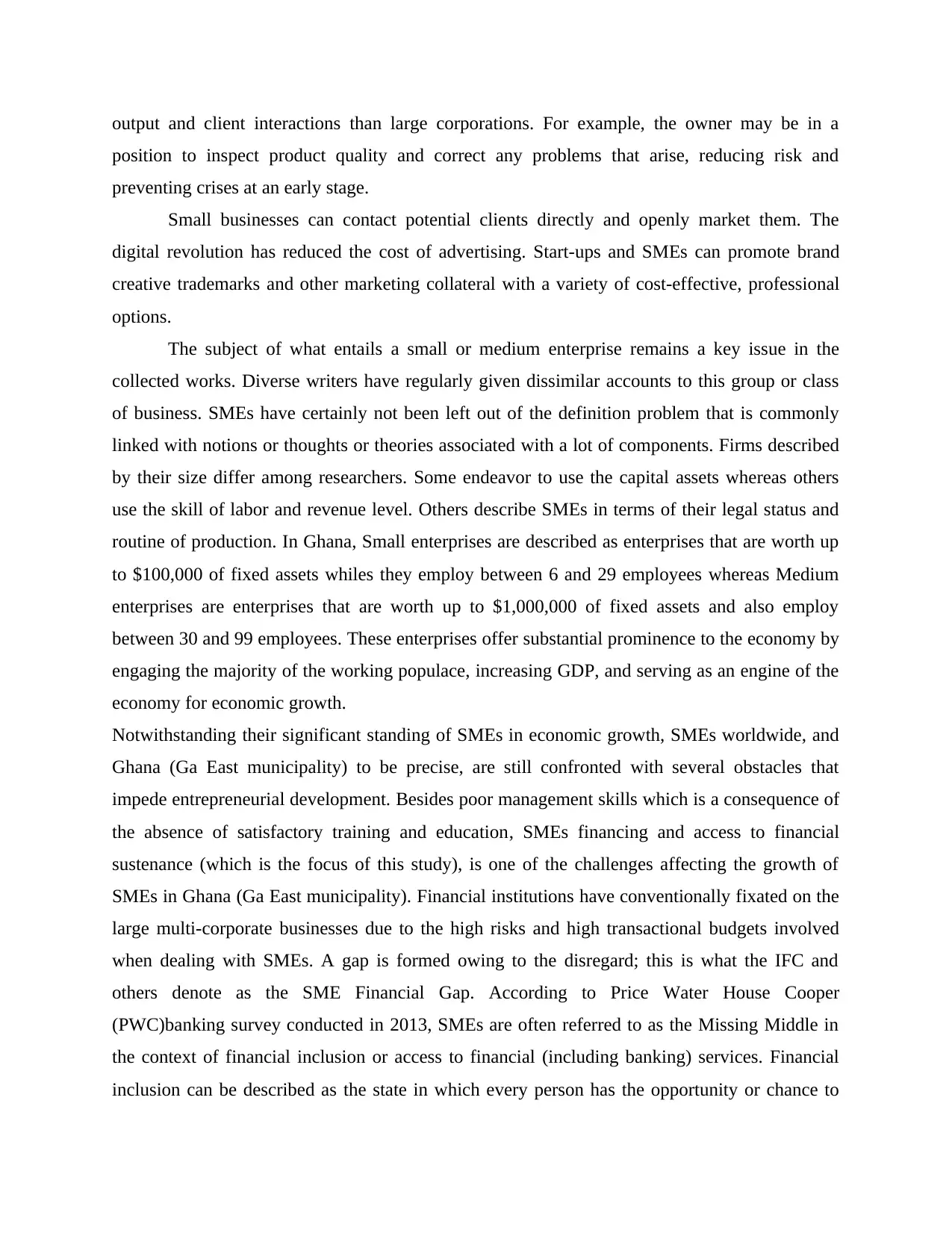
output and client interactions than large corporations. For example, the owner may be in a
position to inspect product quality and correct any problems that arise, reducing risk and
preventing crises at an early stage.
Small businesses can contact potential clients directly and openly market them. The
digital revolution has reduced the cost of advertising. Start-ups and SMEs can promote brand
creative trademarks and other marketing collateral with a variety of cost-effective, professional
options.
The subject of what entails a small or medium enterprise remains a key issue in the
collected works. Diverse writers have regularly given dissimilar accounts to this group or class
of business. SMEs have certainly not been left out of the definition problem that is commonly
linked with notions or thoughts or theories associated with a lot of components. Firms described
by their size differ among researchers. Some endeavor to use the capital assets whereas others
use the skill of labor and revenue level. Others describe SMEs in terms of their legal status and
routine of production. In Ghana, Small enterprises are described as enterprises that are worth up
to $100,000 of fixed assets whiles they employ between 6 and 29 employees whereas Medium
enterprises are enterprises that are worth up to $1,000,000 of fixed assets and also employ
between 30 and 99 employees. These enterprises offer substantial prominence to the economy by
engaging the majority of the working populace, increasing GDP, and serving as an engine of the
economy for economic growth.
Notwithstanding their significant standing of SMEs in economic growth, SMEs worldwide, and
Ghana (Ga East municipality) to be precise, are still confronted with several obstacles that
impede entrepreneurial development. Besides poor management skills which is a consequence of
the absence of satisfactory training and education, SMEs financing and access to financial
sustenance (which is the focus of this study), is one of the challenges affecting the growth of
SMEs in Ghana (Ga East municipality). Financial institutions have conventionally fixated on the
large multi-corporate businesses due to the high risks and high transactional budgets involved
when dealing with SMEs. A gap is formed owing to the disregard; this is what the IFC and
others denote as the SME Financial Gap. According to Price Water House Cooper
(PWC)banking survey conducted in 2013, SMEs are often referred to as the Missing Middle in
the context of financial inclusion or access to financial (including banking) services. Financial
inclusion can be described as the state in which every person has the opportunity or chance to
position to inspect product quality and correct any problems that arise, reducing risk and
preventing crises at an early stage.
Small businesses can contact potential clients directly and openly market them. The
digital revolution has reduced the cost of advertising. Start-ups and SMEs can promote brand
creative trademarks and other marketing collateral with a variety of cost-effective, professional
options.
The subject of what entails a small or medium enterprise remains a key issue in the
collected works. Diverse writers have regularly given dissimilar accounts to this group or class
of business. SMEs have certainly not been left out of the definition problem that is commonly
linked with notions or thoughts or theories associated with a lot of components. Firms described
by their size differ among researchers. Some endeavor to use the capital assets whereas others
use the skill of labor and revenue level. Others describe SMEs in terms of their legal status and
routine of production. In Ghana, Small enterprises are described as enterprises that are worth up
to $100,000 of fixed assets whiles they employ between 6 and 29 employees whereas Medium
enterprises are enterprises that are worth up to $1,000,000 of fixed assets and also employ
between 30 and 99 employees. These enterprises offer substantial prominence to the economy by
engaging the majority of the working populace, increasing GDP, and serving as an engine of the
economy for economic growth.
Notwithstanding their significant standing of SMEs in economic growth, SMEs worldwide, and
Ghana (Ga East municipality) to be precise, are still confronted with several obstacles that
impede entrepreneurial development. Besides poor management skills which is a consequence of
the absence of satisfactory training and education, SMEs financing and access to financial
sustenance (which is the focus of this study), is one of the challenges affecting the growth of
SMEs in Ghana (Ga East municipality). Financial institutions have conventionally fixated on the
large multi-corporate businesses due to the high risks and high transactional budgets involved
when dealing with SMEs. A gap is formed owing to the disregard; this is what the IFC and
others denote as the SME Financial Gap. According to Price Water House Cooper
(PWC)banking survey conducted in 2013, SMEs are often referred to as the Missing Middle in
the context of financial inclusion or access to financial (including banking) services. Financial
inclusion can be described as the state in which every person has the opportunity or chance to
⊘ This is a preview!⊘
Do you want full access?
Subscribe today to unlock all pages.

Trusted by 1+ million students worldwide
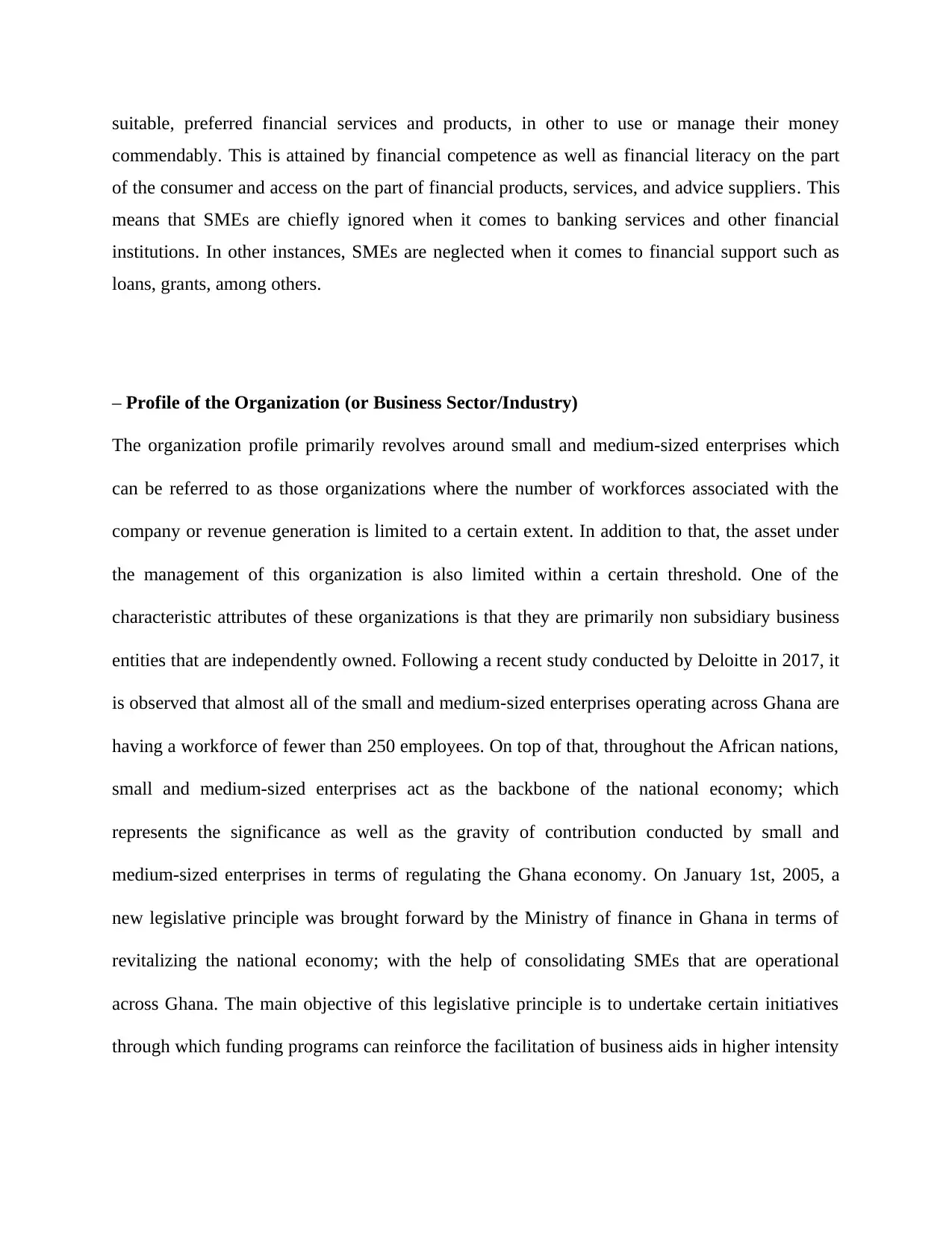
suitable, preferred financial services and products, in other to use or manage their money
commendably. This is attained by financial competence as well as financial literacy on the part
of the consumer and access on the part of financial products, services, and advice suppliers. This
means that SMEs are chiefly ignored when it comes to banking services and other financial
institutions. In other instances, SMEs are neglected when it comes to financial support such as
loans, grants, among others.
– Profile of the Organization (or Business Sector/Industry)
The organization profile primarily revolves around small and medium-sized enterprises which
can be referred to as those organizations where the number of workforces associated with the
company or revenue generation is limited to a certain extent. In addition to that, the asset under
the management of this organization is also limited within a certain threshold. One of the
characteristic attributes of these organizations is that they are primarily non subsidiary business
entities that are independently owned. Following a recent study conducted by Deloitte in 2017, it
is observed that almost all of the small and medium-sized enterprises operating across Ghana are
having a workforce of fewer than 250 employees. On top of that, throughout the African nations,
small and medium-sized enterprises act as the backbone of the national economy; which
represents the significance as well as the gravity of contribution conducted by small and
medium-sized enterprises in terms of regulating the Ghana economy. On January 1st, 2005, a
new legislative principle was brought forward by the Ministry of finance in Ghana in terms of
revitalizing the national economy; with the help of consolidating SMEs that are operational
across Ghana. The main objective of this legislative principle is to undertake certain initiatives
through which funding programs can reinforce the facilitation of business aids in higher intensity
commendably. This is attained by financial competence as well as financial literacy on the part
of the consumer and access on the part of financial products, services, and advice suppliers. This
means that SMEs are chiefly ignored when it comes to banking services and other financial
institutions. In other instances, SMEs are neglected when it comes to financial support such as
loans, grants, among others.
– Profile of the Organization (or Business Sector/Industry)
The organization profile primarily revolves around small and medium-sized enterprises which
can be referred to as those organizations where the number of workforces associated with the
company or revenue generation is limited to a certain extent. In addition to that, the asset under
the management of this organization is also limited within a certain threshold. One of the
characteristic attributes of these organizations is that they are primarily non subsidiary business
entities that are independently owned. Following a recent study conducted by Deloitte in 2017, it
is observed that almost all of the small and medium-sized enterprises operating across Ghana are
having a workforce of fewer than 250 employees. On top of that, throughout the African nations,
small and medium-sized enterprises act as the backbone of the national economy; which
represents the significance as well as the gravity of contribution conducted by small and
medium-sized enterprises in terms of regulating the Ghana economy. On January 1st, 2005, a
new legislative principle was brought forward by the Ministry of finance in Ghana in terms of
revitalizing the national economy; with the help of consolidating SMEs that are operational
across Ghana. The main objective of this legislative principle is to undertake certain initiatives
through which funding programs can reinforce the facilitation of business aids in higher intensity
Paraphrase This Document
Need a fresh take? Get an instant paraphrase of this document with our AI Paraphraser
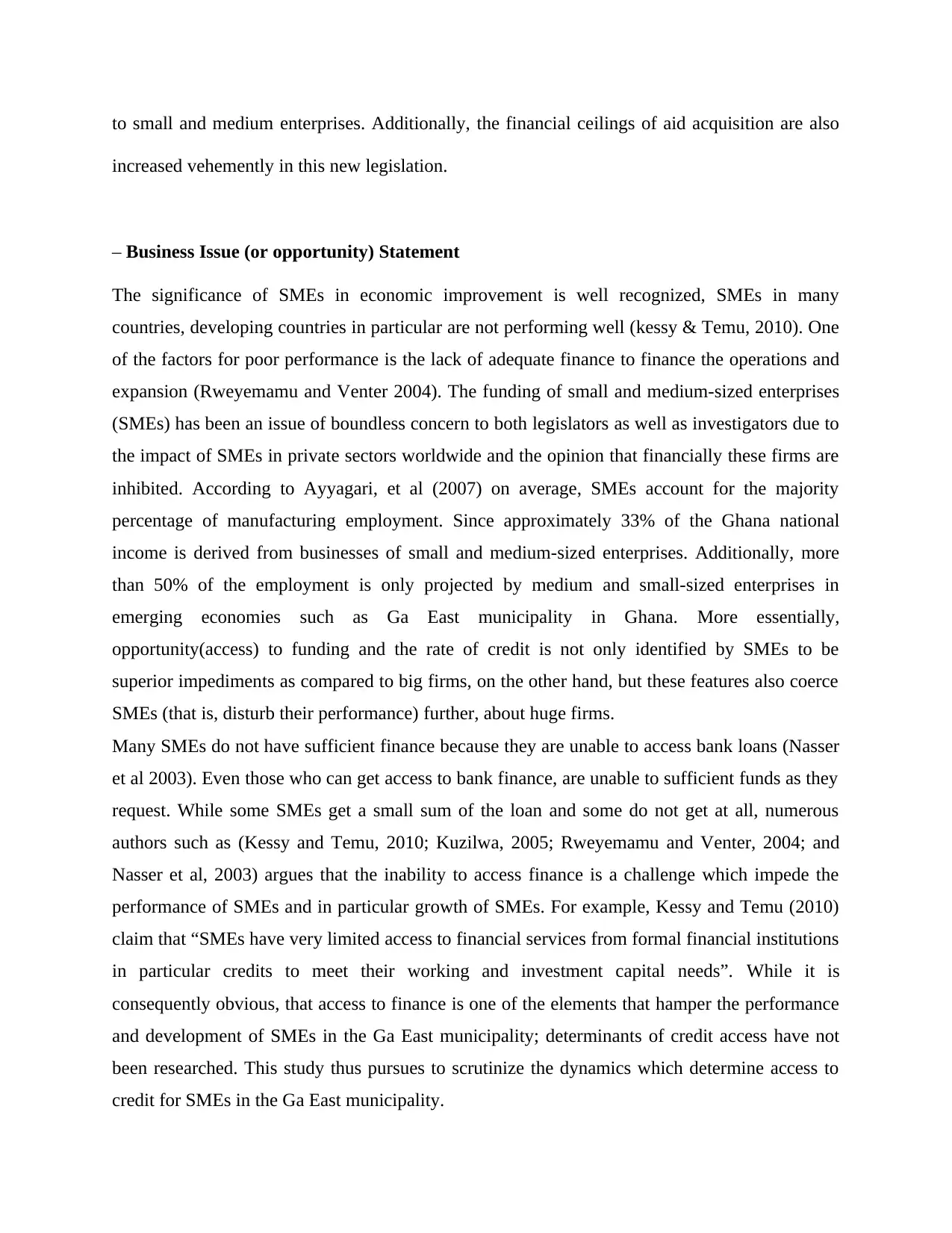
to small and medium enterprises. Additionally, the financial ceilings of aid acquisition are also
increased vehemently in this new legislation.
– Business Issue (or opportunity) Statement
The significance of SMEs in economic improvement is well recognized, SMEs in many
countries, developing countries in particular are not performing well (kessy & Temu, 2010). One
of the factors for poor performance is the lack of adequate finance to finance the operations and
expansion (Rweyemamu and Venter 2004). The funding of small and medium-sized enterprises
(SMEs) has been an issue of boundless concern to both legislators as well as investigators due to
the impact of SMEs in private sectors worldwide and the opinion that financially these firms are
inhibited. According to Ayyagari, et al (2007) on average, SMEs account for the majority
percentage of manufacturing employment. Since approximately 33% of the Ghana national
income is derived from businesses of small and medium-sized enterprises. Additionally, more
than 50% of the employment is only projected by medium and small-sized enterprises in
emerging economies such as Ga East municipality in Ghana. More essentially,
opportunity(access) to funding and the rate of credit is not only identified by SMEs to be
superior impediments as compared to big firms, on the other hand, but these features also coerce
SMEs (that is, disturb their performance) further, about huge firms.
Many SMEs do not have sufficient finance because they are unable to access bank loans (Nasser
et al 2003). Even those who can get access to bank finance, are unable to sufficient funds as they
request. While some SMEs get a small sum of the loan and some do not get at all, numerous
authors such as (Kessy and Temu, 2010; Kuzilwa, 2005; Rweyemamu and Venter, 2004; and
Nasser et al, 2003) argues that the inability to access finance is a challenge which impede the
performance of SMEs and in particular growth of SMEs. For example, Kessy and Temu (2010)
claim that “SMEs have very limited access to financial services from formal financial institutions
in particular credits to meet their working and investment capital needs”. While it is
consequently obvious, that access to finance is one of the elements that hamper the performance
and development of SMEs in the Ga East municipality; determinants of credit access have not
been researched. This study thus pursues to scrutinize the dynamics which determine access to
credit for SMEs in the Ga East municipality.
increased vehemently in this new legislation.
– Business Issue (or opportunity) Statement
The significance of SMEs in economic improvement is well recognized, SMEs in many
countries, developing countries in particular are not performing well (kessy & Temu, 2010). One
of the factors for poor performance is the lack of adequate finance to finance the operations and
expansion (Rweyemamu and Venter 2004). The funding of small and medium-sized enterprises
(SMEs) has been an issue of boundless concern to both legislators as well as investigators due to
the impact of SMEs in private sectors worldwide and the opinion that financially these firms are
inhibited. According to Ayyagari, et al (2007) on average, SMEs account for the majority
percentage of manufacturing employment. Since approximately 33% of the Ghana national
income is derived from businesses of small and medium-sized enterprises. Additionally, more
than 50% of the employment is only projected by medium and small-sized enterprises in
emerging economies such as Ga East municipality in Ghana. More essentially,
opportunity(access) to funding and the rate of credit is not only identified by SMEs to be
superior impediments as compared to big firms, on the other hand, but these features also coerce
SMEs (that is, disturb their performance) further, about huge firms.
Many SMEs do not have sufficient finance because they are unable to access bank loans (Nasser
et al 2003). Even those who can get access to bank finance, are unable to sufficient funds as they
request. While some SMEs get a small sum of the loan and some do not get at all, numerous
authors such as (Kessy and Temu, 2010; Kuzilwa, 2005; Rweyemamu and Venter, 2004; and
Nasser et al, 2003) argues that the inability to access finance is a challenge which impede the
performance of SMEs and in particular growth of SMEs. For example, Kessy and Temu (2010)
claim that “SMEs have very limited access to financial services from formal financial institutions
in particular credits to meet their working and investment capital needs”. While it is
consequently obvious, that access to finance is one of the elements that hamper the performance
and development of SMEs in the Ga East municipality; determinants of credit access have not
been researched. This study thus pursues to scrutinize the dynamics which determine access to
credit for SMEs in the Ga East municipality.
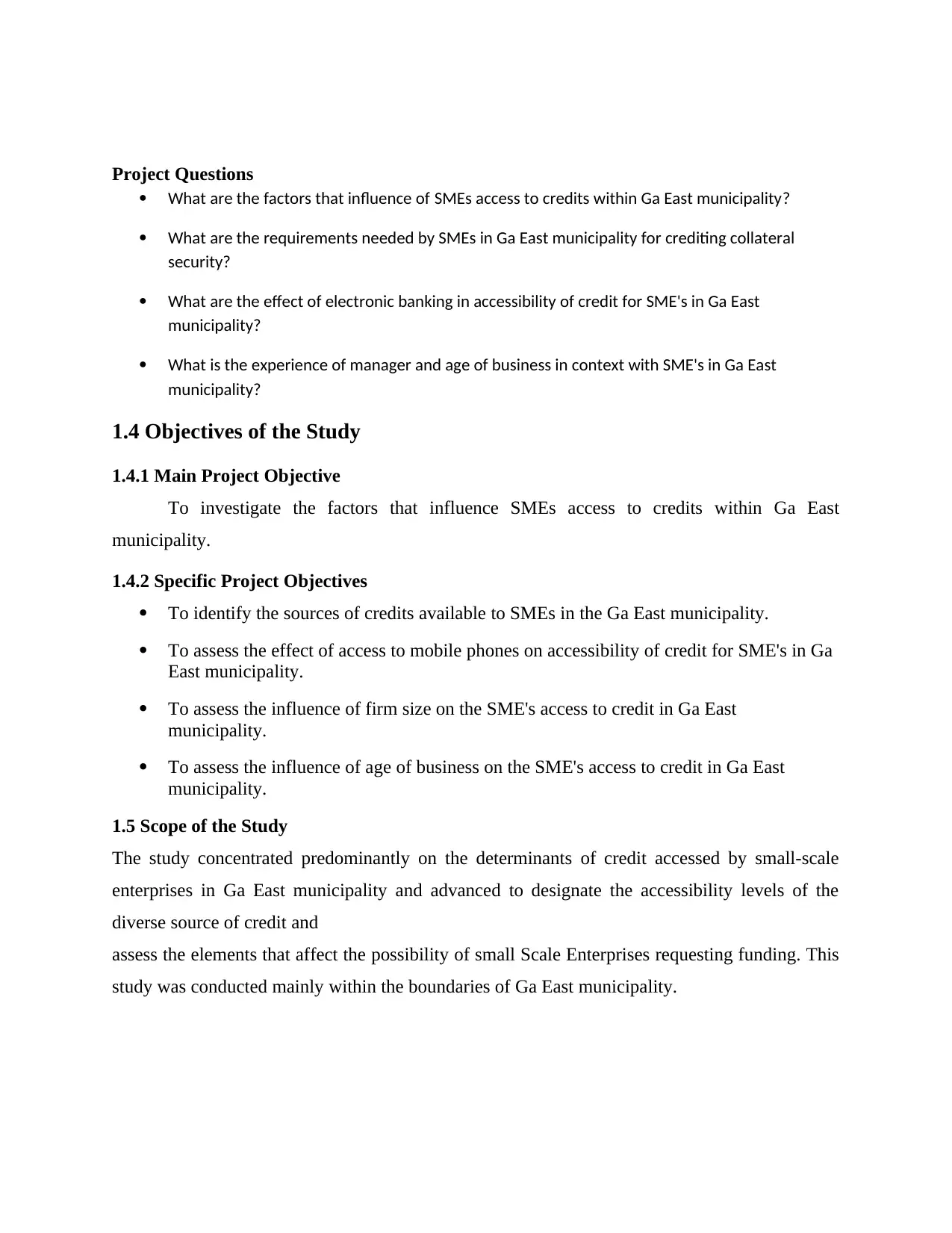
Project Questions
What are the factors that influence of SMEs access to credits within Ga East municipality?
What are the requirements needed by SMEs in Ga East municipality for crediting collateral
security?
What are the effect of electronic banking in accessibility of credit for SME's in Ga East
municipality?
What is the experience of manager and age of business in context with SME's in Ga East
municipality?
1.4 Objectives of the Study
1.4.1 Main Project Objective
To investigate the factors that influence SMEs access to credits within Ga East
municipality.
1.4.2 Specific Project Objectives
To identify the sources of credits available to SMEs in the Ga East municipality.
To assess the effect of access to mobile phones on accessibility of credit for SME's in Ga
East municipality.
To assess the influence of firm size on the SME's access to credit in Ga East
municipality.
To assess the influence of age of business on the SME's access to credit in Ga East
municipality.
1.5 Scope of the Study
The study concentrated predominantly on the determinants of credit accessed by small-scale
enterprises in Ga East municipality and advanced to designate the accessibility levels of the
diverse source of credit and
assess the elements that affect the possibility of small Scale Enterprises requesting funding. This
study was conducted mainly within the boundaries of Ga East municipality.
What are the factors that influence of SMEs access to credits within Ga East municipality?
What are the requirements needed by SMEs in Ga East municipality for crediting collateral
security?
What are the effect of electronic banking in accessibility of credit for SME's in Ga East
municipality?
What is the experience of manager and age of business in context with SME's in Ga East
municipality?
1.4 Objectives of the Study
1.4.1 Main Project Objective
To investigate the factors that influence SMEs access to credits within Ga East
municipality.
1.4.2 Specific Project Objectives
To identify the sources of credits available to SMEs in the Ga East municipality.
To assess the effect of access to mobile phones on accessibility of credit for SME's in Ga
East municipality.
To assess the influence of firm size on the SME's access to credit in Ga East
municipality.
To assess the influence of age of business on the SME's access to credit in Ga East
municipality.
1.5 Scope of the Study
The study concentrated predominantly on the determinants of credit accessed by small-scale
enterprises in Ga East municipality and advanced to designate the accessibility levels of the
diverse source of credit and
assess the elements that affect the possibility of small Scale Enterprises requesting funding. This
study was conducted mainly within the boundaries of Ga East municipality.
⊘ This is a preview!⊘
Do you want full access?
Subscribe today to unlock all pages.

Trusted by 1+ million students worldwide
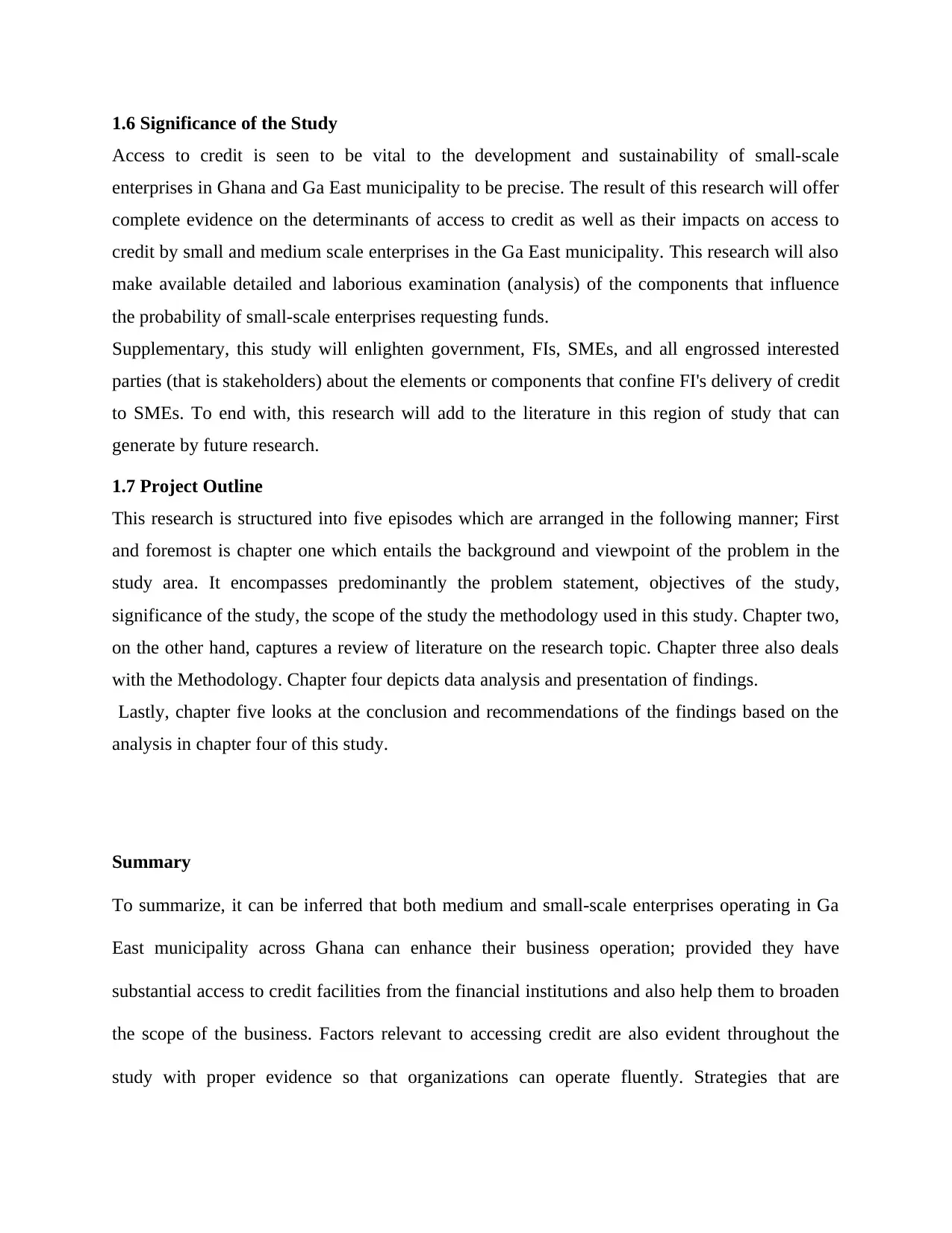
1.6 Significance of the Study
Access to credit is seen to be vital to the development and sustainability of small-scale
enterprises in Ghana and Ga East municipality to be precise. The result of this research will offer
complete evidence on the determinants of access to credit as well as their impacts on access to
credit by small and medium scale enterprises in the Ga East municipality. This research will also
make available detailed and laborious examination (analysis) of the components that influence
the probability of small-scale enterprises requesting funds.
Supplementary, this study will enlighten government, FIs, SMEs, and all engrossed interested
parties (that is stakeholders) about the elements or components that confine FI's delivery of credit
to SMEs. To end with, this research will add to the literature in this region of study that can
generate by future research.
1.7 Project Outline
This research is structured into five episodes which are arranged in the following manner; First
and foremost is chapter one which entails the background and viewpoint of the problem in the
study area. It encompasses predominantly the problem statement, objectives of the study,
significance of the study, the scope of the study the methodology used in this study. Chapter two,
on the other hand, captures a review of literature on the research topic. Chapter three also deals
with the Methodology. Chapter four depicts data analysis and presentation of findings.
Lastly, chapter five looks at the conclusion and recommendations of the findings based on the
analysis in chapter four of this study.
Summary
To summarize, it can be inferred that both medium and small-scale enterprises operating in Ga
East municipality across Ghana can enhance their business operation; provided they have
substantial access to credit facilities from the financial institutions and also help them to broaden
the scope of the business. Factors relevant to accessing credit are also evident throughout the
study with proper evidence so that organizations can operate fluently. Strategies that are
Access to credit is seen to be vital to the development and sustainability of small-scale
enterprises in Ghana and Ga East municipality to be precise. The result of this research will offer
complete evidence on the determinants of access to credit as well as their impacts on access to
credit by small and medium scale enterprises in the Ga East municipality. This research will also
make available detailed and laborious examination (analysis) of the components that influence
the probability of small-scale enterprises requesting funds.
Supplementary, this study will enlighten government, FIs, SMEs, and all engrossed interested
parties (that is stakeholders) about the elements or components that confine FI's delivery of credit
to SMEs. To end with, this research will add to the literature in this region of study that can
generate by future research.
1.7 Project Outline
This research is structured into five episodes which are arranged in the following manner; First
and foremost is chapter one which entails the background and viewpoint of the problem in the
study area. It encompasses predominantly the problem statement, objectives of the study,
significance of the study, the scope of the study the methodology used in this study. Chapter two,
on the other hand, captures a review of literature on the research topic. Chapter three also deals
with the Methodology. Chapter four depicts data analysis and presentation of findings.
Lastly, chapter five looks at the conclusion and recommendations of the findings based on the
analysis in chapter four of this study.
Summary
To summarize, it can be inferred that both medium and small-scale enterprises operating in Ga
East municipality across Ghana can enhance their business operation; provided they have
substantial access to credit facilities from the financial institutions and also help them to broaden
the scope of the business. Factors relevant to accessing credit are also evident throughout the
study with proper evidence so that organizations can operate fluently. Strategies that are
Paraphrase This Document
Need a fresh take? Get an instant paraphrase of this document with our AI Paraphraser
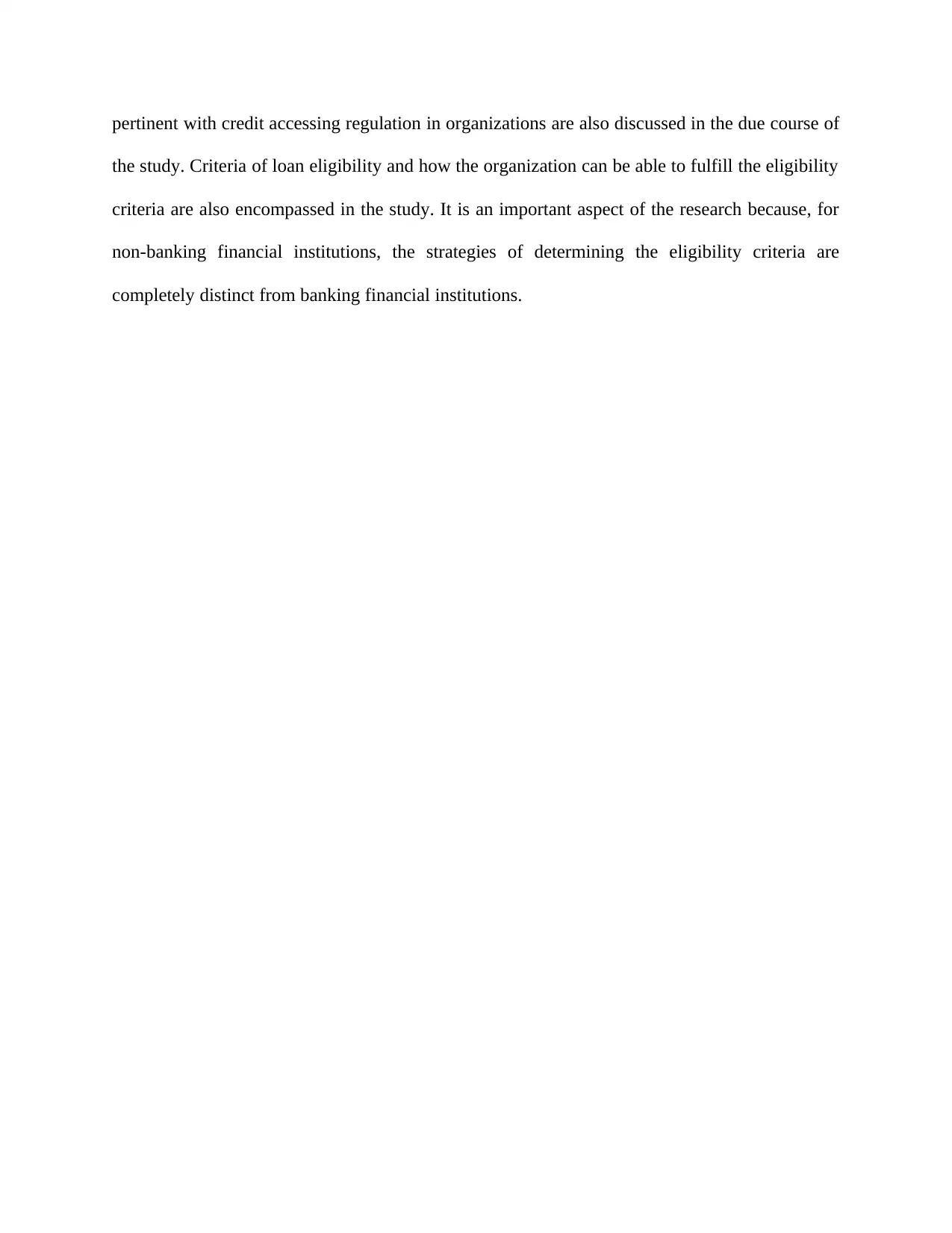
pertinent with credit accessing regulation in organizations are also discussed in the due course of
the study. Criteria of loan eligibility and how the organization can be able to fulfill the eligibility
criteria are also encompassed in the study. It is an important aspect of the research because, for
non-banking financial institutions, the strategies of determining the eligibility criteria are
completely distinct from banking financial institutions.
the study. Criteria of loan eligibility and how the organization can be able to fulfill the eligibility
criteria are also encompassed in the study. It is an important aspect of the research because, for
non-banking financial institutions, the strategies of determining the eligibility criteria are
completely distinct from banking financial institutions.
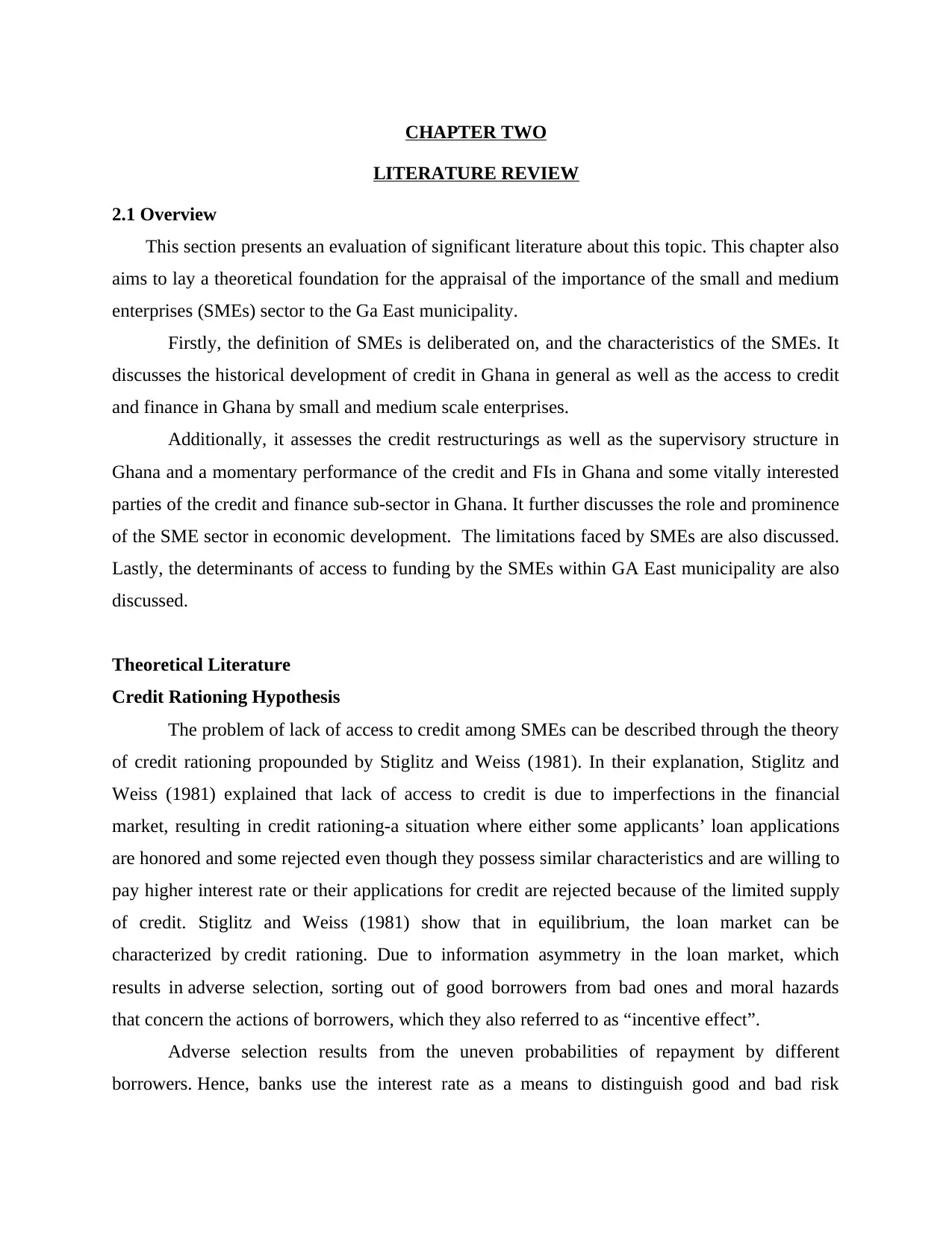
CHAPTER TWO
LITERATURE REVIEW
2.1 Overview
This section presents an evaluation of significant literature about this topic. This chapter also
aims to lay a theoretical foundation for the appraisal of the importance of the small and medium
enterprises (SMEs) sector to the Ga East municipality.
Firstly, the definition of SMEs is deliberated on, and the characteristics of the SMEs. It
discusses the historical development of credit in Ghana in general as well as the access to credit
and finance in Ghana by small and medium scale enterprises.
Additionally, it assesses the credit restructurings as well as the supervisory structure in
Ghana and a momentary performance of the credit and FIs in Ghana and some vitally interested
parties of the credit and finance sub-sector in Ghana. It further discusses the role and prominence
of the SME sector in economic development. The limitations faced by SMEs are also discussed.
Lastly, the determinants of access to funding by the SMEs within GA East municipality are also
discussed.
Theoretical Literature
Credit Rationing Hypothesis
The problem of lack of access to credit among SMEs can be described through the theory
of credit rationing propounded by Stiglitz and Weiss (1981). In their explanation, Stiglitz and
Weiss (1981) explained that lack of access to credit is due to imperfections in the financial
market, resulting in credit rationing-a situation where either some applicants’ loan applications
are honored and some rejected even though they possess similar characteristics and are willing to
pay higher interest rate or their applications for credit are rejected because of the limited supply
of credit. Stiglitz and Weiss (1981) show that in equilibrium, the loan market can be
characterized by credit rationing. Due to information asymmetry in the loan market, which
results in adverse selection, sorting out of good borrowers from bad ones and moral hazards
that concern the actions of borrowers, which they also referred to as “incentive effect”.
Adverse selection results from the uneven probabilities of repayment by different
borrowers. Hence, banks use the interest rate as a means to distinguish good and bad risk
LITERATURE REVIEW
2.1 Overview
This section presents an evaluation of significant literature about this topic. This chapter also
aims to lay a theoretical foundation for the appraisal of the importance of the small and medium
enterprises (SMEs) sector to the Ga East municipality.
Firstly, the definition of SMEs is deliberated on, and the characteristics of the SMEs. It
discusses the historical development of credit in Ghana in general as well as the access to credit
and finance in Ghana by small and medium scale enterprises.
Additionally, it assesses the credit restructurings as well as the supervisory structure in
Ghana and a momentary performance of the credit and FIs in Ghana and some vitally interested
parties of the credit and finance sub-sector in Ghana. It further discusses the role and prominence
of the SME sector in economic development. The limitations faced by SMEs are also discussed.
Lastly, the determinants of access to funding by the SMEs within GA East municipality are also
discussed.
Theoretical Literature
Credit Rationing Hypothesis
The problem of lack of access to credit among SMEs can be described through the theory
of credit rationing propounded by Stiglitz and Weiss (1981). In their explanation, Stiglitz and
Weiss (1981) explained that lack of access to credit is due to imperfections in the financial
market, resulting in credit rationing-a situation where either some applicants’ loan applications
are honored and some rejected even though they possess similar characteristics and are willing to
pay higher interest rate or their applications for credit are rejected because of the limited supply
of credit. Stiglitz and Weiss (1981) show that in equilibrium, the loan market can be
characterized by credit rationing. Due to information asymmetry in the loan market, which
results in adverse selection, sorting out of good borrowers from bad ones and moral hazards
that concern the actions of borrowers, which they also referred to as “incentive effect”.
Adverse selection results from the uneven probabilities of repayment by different
borrowers. Hence, banks use the interest rate as a means to distinguish good and bad risk
⊘ This is a preview!⊘
Do you want full access?
Subscribe today to unlock all pages.

Trusted by 1+ million students worldwide
1 out of 72
Related Documents
Your All-in-One AI-Powered Toolkit for Academic Success.
+13062052269
info@desklib.com
Available 24*7 on WhatsApp / Email
![[object Object]](/_next/static/media/star-bottom.7253800d.svg)
Unlock your academic potential
Copyright © 2020–2025 A2Z Services. All Rights Reserved. Developed and managed by ZUCOL.





